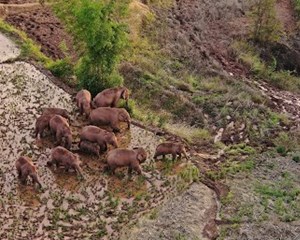JUDY WOODRUFF: It's not a sight you see every day, a herd of elephants, leaving their home turf, making their way through Southwestern China, most recently stopping in a city of millions. But that is what's happening right now. William Brangham looks at their mysterious trek, and why they might have hit the road in the first place.
WILLIAM BRANGHAM: It's been an epic and highly unusual journey so far, more than 300 miles over the last year, across deserts, through forests, crossing busy city streets, navigating ditches. This herd of 15 Asian elephants is captivating China. Every step of their trek documented on state-run media, and seemingly everywhere on Chinese social media. The world can't seem to get enough of this trip, a trip to -- well, nobody quite knows where. They stop for naps, though the adults seem more tuckered out than their offspring. They eat corn in the fields, even try to break into power plants. But why are they on this journey? I asked conservation biologist Peter Leimgruber that very question at the Smithsonian's National Zoo in Washington, D.C.
PETER LEIMGRUBER, Smithsonian's National Zoo: We don't have a clear answer, but I think that we have some guesses or ideas. Usually, these elephants move when they are being disturbed by people, or when they lose their habitat, or when they're trying to find food. So they might move out of the forest into the agriculture and find some food there. But they usually don't move distances that are as long as this.
WILLIAM BRANGHAM: Is that right? So, this -- the length of their journey is unusual?
PETER LEIMGRUBER: That's the most unusual piece. So, it's very common for them to move into agriculture, but it's very unusual for elephants to move in a straight line distance for hundreds of miles or kilometers.
WILLIAM BRANGHAM: Leimgruber has studied Asian elephants for decades, and took us in for a closer look. So, the differences between an Asian elephant and the larger elephants people will see in Africa, what are the differences?
PETER LEIMGRUBER: Oh, there are lots, so, first of all, the size. So these are between three and five tons, and an African elephant would be between five and seven tons, so it's quite a bit bigger. The head is shaped differently.
WILLIAM BRANGHAM: Still seems pretty big.

PETER LEIMGRUBER: Yes, it's very big, yes.
PETER LEIMGRUBER: Yes. Yes. Yes. Yes. Yes.
WILLIAM BRANGHAM: These elephants are endangered. There are only around 30,000 to 50,000 left, down from 100,000 at the beginning of the 20th century, and a lot of that is because of human expansion.
PETER LEIMGRUBER: We can show with our research that this expansion of human activity is further and further restricting the movements of individual animals, as well as entire populations of animals. And there's a limit, right? So, if you keep restricting their movement, eventually, these populations, they just have to decline. There's just not enough space for them to move enough and find enough food and do all the things they need to do.
WILLIAM BRANGHAM: For the wandering herd in China, authorities are working carefully to keep both people and elephants safe. They're trying to guide this group away from cities, and back to a safer home. For the "PBS NewsHour" in Washington, D.C., I'm William Brangham.
JUDY WOODRUFF: And we just hope they stay safe. Thank you, William.












